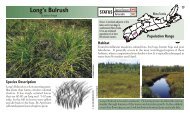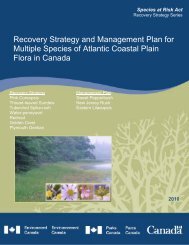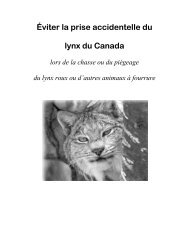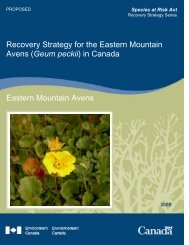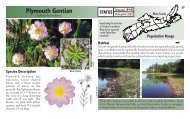Healthy Lakes and Wetlands For Tomorrow - Species at Risk
Healthy Lakes and Wetlands For Tomorrow - Species at Risk
Healthy Lakes and Wetlands For Tomorrow - Species at Risk
Create successful ePaper yourself
Turn your PDF publications into a flip-book with our unique Google optimized e-Paper software.
WILDLIFE <strong>and</strong> PETS<br />
We appreci<strong>at</strong>e our pets <strong>and</strong> the presence of wildlife on our property, but need to be careful<br />
to ensure we are not neg<strong>at</strong>ively impacting the environment around us. Wildlife is just th<strong>at</strong><br />
– wild. By being aware of how our actions affect the plants <strong>and</strong> animals around us, we can<br />
make sure th<strong>at</strong> the n<strong>at</strong>ural environment maintains its healthy form <strong>and</strong> function.<br />
Maintain n<strong>at</strong>ural levels of wild animals by reducing<br />
<strong>and</strong> elimin<strong>at</strong>ing <strong>at</strong>tractants on your property.<br />
• Place all garbage in good storage containers th<strong>at</strong> cannot be<br />
accessed by animals.<br />
• Do not feed wildlife.<br />
• Keep your compost far away from w<strong>at</strong>er in a sealed, animal-proof container. Turn regularly to reduce<br />
odours.<br />
• Keep all pet food inside.<br />
W<strong>at</strong>er-Pennywort<br />
Common Nighthawk<br />
Popul<strong>at</strong>ions of wild animals such as squirrels <strong>and</strong> raccoons generally increase in developed areas. These<br />
animals can impact turtle popul<strong>at</strong>ions by preying on h<strong>at</strong>chlings <strong>and</strong> digging up turtle nests to e<strong>at</strong> the eggs.<br />
It is important to remember th<strong>at</strong> pred<strong>at</strong>ors are not “bad” species <strong>and</strong> th<strong>at</strong> pred<strong>at</strong>ion is a part of a n<strong>at</strong>ural<br />
ecosystem. However, by keeping our l<strong>and</strong> free of <strong>at</strong>tractants, we can avoid artificially raising pred<strong>at</strong>or<br />
popul<strong>at</strong>ions to levels th<strong>at</strong> would not occur n<strong>at</strong>urally.<br />
35<br />
You are responsible for your pet <strong>and</strong> its actions. Keep your c<strong>at</strong> <strong>and</strong> dog on a leash or<br />
in an enclosed area when outdoors.<br />
C<strong>at</strong>s <strong>and</strong> dogs can disturb <strong>and</strong> kill wildlife. Under the Nova Scotia Wildlife Act it is against the law to allow<br />
a dog to run “<strong>at</strong> large” or unaccompanied by its owner. Free-roaming c<strong>at</strong>s are estim<strong>at</strong>ed to kill hundreds<br />
of millions of birds, reptiles, amphibians <strong>and</strong> mammals every year. One c<strong>at</strong> can have a huge impact on<br />
wildlife (even if it has a bell or is de-clawed), <strong>and</strong> can kill many animals per week. Most wildlife kills go<br />
unnoticed <strong>and</strong> it is difficult for a pet owner to realize the full impact of their pet.<br />
Prevent the spread of invasive species when fishing <strong>and</strong> bo<strong>at</strong>ing.<br />
• Do not move fish from one lake or stream into another.<br />
• Do not release live bait (see page 37 for a list of prohibited bait species).<br />
• Drain live wells <strong>and</strong> bilge w<strong>at</strong>er from your bo<strong>at</strong> before leaving a w<strong>at</strong>er body. Remove all plants, mussels,<br />
<strong>and</strong> other visible organisms from your bo<strong>at</strong>.<br />
• Wash or dry all your fishing gear (trailer, boots, tackle, etc) away from w<strong>at</strong>er bodies to kill the aqu<strong>at</strong>ic<br />
species on them, which can live for two weeks out of the w<strong>at</strong>er.




